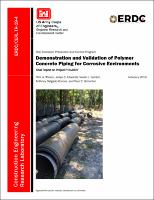Please use this identifier to cite or link to this item:
https://hdl.handle.net/11681/32320Full metadata record
| DC Field | Value | Language |
|---|---|---|
| dc.contributor.author | Wilson, Clint A. | - |
| dc.contributor.author | Edwards, Jaclyn S. | - |
| dc.contributor.author | Lamkin, Sarah L. | - |
| dc.contributor.author | Simonton, Paul C. | - |
| dc.contributor.author | Delgado-Connor, Anthony | en_US |
| dc.date.accessioned | 2019-03-07T18:35:31Z | - |
| dc.date.available | 2019-03-07T18:35:31Z | - |
| dc.date.issued | 2019-02 | - |
| dc.identifier.govdoc | ERDC/CERL TR-19-4 | - |
| dc.identifier.uri | https://hdl.handle.net/11681/32320 | - |
| dc.identifier.uri | http://dx.doi.org/10.21079/11681/32320 | - |
| dc.description | Technical Report | - |
| dc.description.abstract | Sewer pipes and structures that convey aggressive wastewaters or are exposed to aggressive soil types can rapidly deteriorate, leading to premature leakage and service failure. This problem impacts mission execution on U.S. military installations by creating operational disruptions that require unplanned emergency repairs, increasing operational costs and reducing infrastructure service life. An emerging alternate material, polymer concrete, is made with high-strength resins and aggregates that have excellent resistance to corrosive factors inside and out as compared with standard concrete. Polymer concrete also has relatively high compressive, tensile, shear, and flexural strengths compared to ordinary concrete. This report documents a field demonstration of a polymer concrete pipe (PCP) structure measuring 24 in. diameter by approximately 200 linear feet, including seven manholes and two junction boxes. Performance was monitored through coupon testing in the wet well and in the laboratory. Results indicate that PCP is significantly more resistant to sulfuric acid than Portland cement concrete. PCP is relatively new to wastewater applications, so extra attention is needed during acquisition because practices recommended by polymer concrete manufacturers may differ from those used in conventional wastewater infrastructure projects. The calculated return on investment for this project is 9.27. | en_US |
| dc.description.sponsorship | Department of Defense Corrosion Prevention and Control Program (U.S.) | en_US |
| dc.description.sponsorship | United States. Office of the Under Secretary of Defense for Acquisition, Technology, and Logistics. | - |
| dc.description.tableofcontents | Abstract .................................................................................................................................... ii Figures and Tables ................................................................................................................... v Preface ..................................................................................................................................... vi Unit Conversion Factors ........................................................................................................ vii 1 Introduction ...................................................................................................................... 1 1.1 Problem statement ............................................................................................ 1 1.2 Objectives ........................................................................................................... 2 1.3 Approach ............................................................................................................ 2 1.4 Metrics................................................................................................................ 3 2 Technical Investigation ................................................................................................... 5 2.1 Technology overview .......................................................................................... 5 2.2 Field work ........................................................................................................... 7 2.2.1 Polymer concrete manholes ....................................................................................... 8 2.2.2 Polymer concrete pipe .............................................................................................. 12 2.2.3 Polymer concrete junction boxes ............................................................................. 15 2.3 Commissioning and monitoring ...................................................................... 16 2.3.1 Field/construction verification of properly installed technology ............................ 16 2.3.2 Field performance monitoring and testing .............................................................. 17 2.3.3 Laboratory performance testing .............................................................................. 18 3 Discussion ....................................................................................................................... 22 3.1 Field coupon testing ....................................................................................... 22 3.2 CERL laboratory test results .......................................................................... 22 3.2.1 Thickness comparisons ............................................................................................ 22 3.2.2 Visual inspections ..................................................................................................... 23 3.2.3 Mass loss comparisons ............................................................................................ 23 3.2.4 Scanning electron microscopy (SEM) imaging ........................................................ 24 3.2.5 Energy-dispersive X-ray spectroscopy ...................................................................... 27 3.3 Third-party compression tests ....................................................................... 29 3.4 Lessons learned ............................................................................................. 29 4 Economic Analysis ......................................................................................................... 32 4.1 Costs and assumptions .................................................................................. 32 4.1.1 Alternative 1 (baseline case) .................................................................................... 32 4.1.2 Alternative 2 (polymer concrete) .............................................................................. 33 4.2 Projected return on investment (ROI) ............................................................ 34 5 Conclusions and Recommendations ........................................................................... 37 5.1 Conclusions ...................................................................................................... 37 5.2 Recommendations .......................................................................................... 37 5.2.1 Applicability ............................................................................................................... 37 5.2.2 Implementation ......................................................................................................... 37 References ............................................................................................................................. 39 Appendix A: Chemical Corrosion Resistance of Resin in PCP ........................................ 41 Appendix B: Contract Specifications ................................................................................. 49 Appendix C: Interpipe Shop Drawings ................................................................................ 59 Appendix D: PPT/Interpipe Design Calculation Methodology ........................................ 73 Appendix E: Cost Comparison of Polymer Concrete versus Traditional Materials for Wastewater Pipe, Manholes, and Structures ...................................... 88 Report Documentation Page | - |
| dc.format.extent | 100 pages / 16.99 Mb | - |
| dc.format.medium | PDF/A | - |
| dc.language.iso | en_US | en_US |
| dc.publisher | Construction Engineering Research Laboratory (U.S.) | en_US |
| dc.publisher | Engineer Research and Development Center (U.S.) | - |
| dc.relation.ispartofseries | Technical Report (Engineer Research and Development Center (U.S.)) ; no. ERDC/CERL TR-19-4 | - |
| dc.rights | Approved for Public Release; Distribution is Unlimited | - |
| dc.source | This Digital Resource was created in Microsoft Word and Adobe Acrobat | - |
| dc.subject | Military bases | en_US |
| dc.subject | Pipe, Concrete | en_US |
| dc.subject | Sewerage | en_US |
| dc.subject | Corrosion and anti-corrosives | en_US |
| dc.subject | Polymer-impregnated concrete--Evaluation | en_US |
| dc.subject | Polymer concrete piping (PCP) | en_US |
| dc.title | Demonstration and validation of polymer concrete piping for corrosive environments : final report on Project F14-AR07 | en_US |
| dc.type | Report | en_US |
| Appears in Collections: | Technical Report | |
Files in This Item:
| File | Description | Size | Format | |
|---|---|---|---|---|
| ERDC-CERL TR-19-4.pdf | 17.4 MB | Adobe PDF |  View/Open |